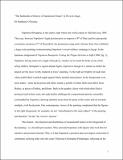Files in this item
The sediments of history in Napoleonic France
Item metadata
| dc.contributor.author | O'Rourke, Stephanie | |
| dc.date.accessioned | 2022-11-25T00:39:25Z | |
| dc.date.available | 2022-11-25T00:39:25Z | |
| dc.date.issued | 2021-05-25 | |
| dc.identifier | 269904209 | |
| dc.identifier | daaa84c2-636a-46f3-a0bf-4313d785ca30 | |
| dc.identifier | 85106755513 | |
| dc.identifier.citation | O'Rourke , S 2021 , ' The sediments of history in Napoleonic France ' , Word & Image , vol. 37 , no. 1 , pp. 6-20 . https://doi.org/10.1080/02666286.2020.1866797 | en |
| dc.identifier.issn | 0266-6286 | |
| dc.identifier.other | ORCID: /0000-0001-6823-4282/work/94669861 | |
| dc.identifier.uri | https://hdl.handle.net/10023/26497 | |
| dc.description.abstract | This essay uses the work of the French artist Antoine-Jean Gros as a prompt to reconsider the means by which historical meaning was narrated and disseminated in Napoleonic France, analyzing a number of interrelated pictorial, discursive, and material practices. Gros’s large-scale paintings participated in an early nineteenth-century model of historical meaning that was characterized by dispersal and aggregation, by fragmentation and proliferation. I look first at the ascendance of history as a popular genre or medium, then to the literal means by which historical signifiers were collected during Bonaparte’s military campaigns and subsequently disseminated textually and pictorially, before returning, at the end, to Gros. An essentially cumulative form of historical meaning emerges that can be traced across a range of locations and modalities in Napoleonic France. | |
| dc.format.extent | 298369 | |
| dc.language.iso | eng | |
| dc.relation.ispartof | Word & Image | en |
| dc.subject | Antoine-Jean Gros | en |
| dc.subject | Napoleon Bonaparte | en |
| dc.subject | Archaeology | en |
| dc.subject | Egyptology | en |
| dc.subject | Historicism | en |
| dc.subject | ND Painting | en |
| dc.subject | DC France | en |
| dc.subject | CC Archaeology | en |
| dc.subject | T-NDAS | en |
| dc.subject.lcc | ND | en |
| dc.subject.lcc | DC | en |
| dc.subject.lcc | CC | en |
| dc.title | The sediments of history in Napoleonic France | en |
| dc.type | Journal article | en |
| dc.contributor.institution | University of St Andrews. School of Art History | en |
| dc.contributor.institution | University of St Andrews. Centre for Contemporary Art | en |
| dc.identifier.doi | https://doi.org/10.1080/02666286.2020.1866797 | |
| dc.description.status | Peer reviewed | en |
| dc.date.embargoedUntil | 2022-11-25 |
This item appears in the following Collection(s)
Items in the St Andrews Research Repository are protected by copyright, with all rights reserved, unless otherwise indicated.

